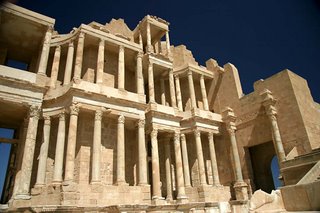Exploring Libya
Unbeknownst to many, Libya is home to many of the worlds most spectacular ancient ruins. Archaeological evidence indicates that from as early as the 8th millennium BCE, Libya's coastal plain was inhabited by a Neolithic people who were skilled in the domestication of cattle and the cultivation of crops. Over the course of its history, Libya has played host to Phoenecians, Carthaginians, the armies of Alexander the Great, Romans, Vandals, and Byzantines, all of whom settled along the Mediterranean coastal plain in the vicinity of modern-day Tripoli.
Courtesy wikipedia:
"Tripoli, was originally a group of Phoenician colonies dependent on Carthage. Phoenicians founded the three great cities (tri + polis) of Oea, Sabrata and Leptis Magna (site of magnificent Roman ruins). Carthage and its dependencies fell to Rome after the Third Punic War. Tripoli is the ancient sea port at the terminus of three great caravan routes linking the coast with Lake Chad and Timbuktu across the Sahara. Near the port of Tripoli stands a Roman triumphal arch with four richly sculpured fronts of white marble, the blocks being held together with cramps. It was begun in the reign of the emperor Antoninus Pius, according to a still-unmutilated dedicatory inscription, and finished under Marcus Aurelius."
Today there stands a restaurant directly facing the Marcus Aurelius arch, which I dined at last night. The food was at best mediocre, but with outdoor seating facing this magnificent archway, the view was unparalleled. I intend to go there with my tripod at night sometime and take some photographs.
The wikipedia excerpt also mentioned Sabrata, which is where I spent most of my Friday this past weekend (follow link for wikipedia page with more information). It was very impressive overall. Well-preserved, well-maintained and well-restored. When we first arrived, there were a couple tour groups from the cruise ships that dock in Tripoli, but they left after a couple hours and my two flatmates and I literally had the entire site to ourselves. This is the beauty of the undiscovered nature of Libya at the moment. One can enjoy these sorts of sites without the experience being sullied by hoards of annoying tourists (and yes, I realize the irony that I myself am a tourist, but that doesn't mean I'd enjoy being surrounded by a bunch of "me"s). I don't expect it to remain that way very long. Like I said, cruise ships have started docking in Tripoli and the trickle of tourists is slowly turning into a stream. I give it 5 - 10 years before it becomes a full-blown flood. I hope the local authorities manage it well so that it doesn't ruin the ruins.
Some photographs from Sabrata (click to enlarge, to be updated with more soon):










Well, after all that archeological exploration in the hot Libyan sun, Tomas, Stephen and I were ready for a swim. So we found ourselves a nice beach and went for a dip. Sorry, no photos, as much as I know that you are all dying to see me in my swimming attire. Might I just say, however, that the Mediterranean is my favourite body of water.
Check back for more pictures once I've resized them for posting.
Salaam!



6 Comments:
It's interesting how abundant Libyan is with colonial reminders of a Roman history. My thesis advisor specialized in a type of pottery unique to Libya (which was produced at the palace of Septimius Severus) and so I was able to research into the country more than I would have otherwise. If you are interested, I can recommend some good archaeological books, if you are indeed that bored. In fact, I just did a mini study on gladiators in Roman provinces, with a specialization on African regions and the adoption of gladiatorial games. I just realized you probably did not want to hear this much about my research. I am a nerd.
Libyan = Libya.
I'm not exactly proficient with what you call "grammar".
Or spelling.
The sky looks the way it does because I was using a polarizing filter, which gives the sky a deep blue hue. Sometimes people complain that over-use a polarizing filter can make pictures look unnatural, but I like the effect. Also, there was some post-production processing done in photoshop, but that was mainly just adjusting colour levels and sharpening. The sky really was beautiful that day, and despite shooting at almost midday (worst time for photography) I think I came out with some pretty good pictures.
Oh, and I'm glad we've agreed that there will be no fighting...Shakira, Shakira...
I think if you visited the Mediterranean, it would win you over.
Fabulous photos. Nice to see a little bit of Libya.
I'm going to have to go for the Adriatic as favourite body of water.
But....no fighting!
wow, jf with the camera & shop talk. impressive ;)
(and they are nice photos, especially the date palm)
Post a Comment
<< Home